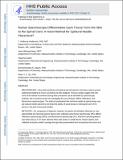| dc.contributor.author | Anderson, T. Anthony | |
| dc.contributor.author | Kang, Jeon Woong | |
| dc.contributor.author | Gubin, Tatyana A. | |
| dc.contributor.author | Dasari, Ramachandra Rao | |
| dc.contributor.author | So, Peter T. C. | |
| dc.date.accessioned | 2019-01-15T19:23:57Z | |
| dc.date.available | 2019-01-15T19:23:57Z | |
| dc.date.issued | 2016-10 | |
| dc.identifier.issn | 0003-3022 | |
| dc.identifier.uri | http://hdl.handle.net/1721.1/120075 | |
| dc.description.abstract | Background: Neuraxial anesthesia and epidural steroid injection techniques require precise anatomical targeting to ensure successful and safe analgesia. Previous studies suggest that only some of the tissues encountered during these procedures can be identified by spectroscopic methods, and no previous study has investigated the use of Raman, diffuse reflectance, and fluorescence spectroscopies. The authors hypothesized that real-time needle-tip spectroscopy may aid epidural needle placement and tested the ability of spectroscopy to distinguish each of the tissues in the path of neuraxial needles. Methods: For comparison of detection methods, the spectra of individual, dissected ex vivo paravertebral and neuraxial porcine tissues were collected using Raman spectroscopy (RS), diffuse reflectance spectroscopy, and fluorescence spectroscopy. Real-time spectral guidance was tested using a 2-mm inner-diameter fiber-optic probe-in-needle device. Raman spectra were collected during the needle's passage through intact paravertebral and neuraxial porcine tissue and analyzed afterward. The RS tissue signatures were verified as mapping to individual tissue layers using histochemical staining and widefield microscopy. Results: RS revealed a unique spectrum for all ex vivo paravertebral and neuraxial tissue layers; diffuse reflectance spectroscopy and fluorescence spectroscopy were not distinct for all tissues. Moreover, when accounting for the expected order of tissues, real-time Raman spectra recorded during needle insertion also permitted identification of each paravertebral and neuraxial porcine tissue. Conclusions: This study demonstrates that RS can distinguish the tissues encountered during epidural needle insertion. This technology may prove useful during needle placement by providing evidence of its anatomical localization. | en_US |
| dc.publisher | Ovid Technologies (Wolters Kluwer Health) | en_US |
| dc.relation.isversionof | http://dx.doi.org/10.1097/ALN.0000000000001249 | en_US |
| dc.rights | Creative Commons Attribution-Noncommercial-Share Alike | en_US |
| dc.rights.uri | http://creativecommons.org/licenses/by-nc-sa/4.0/ | en_US |
| dc.source | PMC | en_US |
| dc.title | Raman Spectroscopy Differentiates Each Tissue from the Skin to the Spinal Cord | en_US |
| dc.type | Article | en_US |
| dc.identifier.citation | Anderson, T. Anthony et al. “Raman Spectroscopy Differentiates Each Tissue from the Skin to the Spinal Cord.” Anesthesiology 125, 4 (October 2016): 793–804 © 2016 American Society of Anesthesiologists, Inc. and Wolters Kluwer Health, Inc. | en_US |
| dc.contributor.department | Massachusetts Institute of Technology. Department of Biological Engineering | en_US |
| dc.contributor.department | Massachusetts Institute of Technology. Department of Chemistry | en_US |
| dc.contributor.department | Massachusetts Institute of Technology. Department of Mechanical Engineering | en_US |
| dc.contributor.mitauthor | Kang, Jeon Woong | |
| dc.contributor.mitauthor | Gubin, Tatyana A. | |
| dc.contributor.mitauthor | Dasari, Ramachandra Rao | |
| dc.contributor.mitauthor | So, Peter T. C. | |
| dc.relation.journal | Anesthesiology | en_US |
| dc.eprint.version | Author's final manuscript | en_US |
| dc.type.uri | http://purl.org/eprint/type/JournalArticle | en_US |
| eprint.status | http://purl.org/eprint/status/PeerReviewed | en_US |
| dc.date.updated | 2019-01-03T18:04:46Z | |
| dspace.orderedauthors | Anderson, T. Anthony; Kang, Jeon Woong; Gubin, Tatyana; Dasari, Ramachandra R.; So, Peter T. C. | en_US |
| dspace.embargo.terms | N | en_US |
| dc.identifier.orcid | https://orcid.org/0000-0003-2012-9023 | |
| dc.identifier.orcid | https://orcid.org/0000-0003-4698-6488 | |
| mit.license | OPEN_ACCESS_POLICY | en_US |
